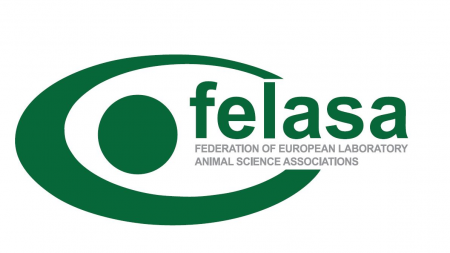-
FELASA:
- General information.
- Accomodation.
- Travel information.
- Registration.
- Organisational Management.
- Competences.
- Skills and monitoring.
- FELASA 4 - 2017:
- FELASA 5 - 2018:
- FELASA 6 - 2019:
- FELASA 7 - 2020:
- FELASA 8 - 2022:
- FELASA 9 - 2023:
- FELASA 10 - 2024:
- FELASA 11 - 2024:
- FELASA 12 - 2025:
- FELASA 13 - 2026:
- .
- .
Competences

Competences of theoretical training (FELASA B)
The participant will be able to:
- Describe and explain the national and EU laws and guidances which regulate the scientific use of animals, and in particular the activities of those carrying out scientific procedures involving them.
- Describe and discuss the importance of the 3 Rs (reduction, replacement, refinement), the ethical and animal welfare guiding principles.
- Be aware of basic anatomy, physiology, reproduction and behavioral characteristics of the relevant species.
- Describe suitable routines and husbandry practices for the maintenance, care and welfare for a range of animals used in research, to include small laboratory species and large animal species where appropriate.
- Describe how to provide water and an appropriate diet for laboratory animals including the sourcing, storage and presentation of suitable foodstuffs and water.
- Identify potential disease risks in the animal facility, including specific predisposing factors which may be relevant.
- List potential human health hazards associated with contact with laboratory animals (including allergy, injury, infection, zoonosis) and how these can be prevented.
- Describe methods available for maintaining appropriate health status (including use of barriers, different containment levels use of sentinels as relevant to the species).
- Recognize the life events that cause abnormal behavior and signs of discomfort, pain, suffering, or distress, including the transportation, maintenance, breeding, management and other procedures.
- Describe the commonly used drugs and indications for their usage during premedication and induction and maintenance of anesthesia of the relevant laboratory animals.
- Define and apply appropriate humane end-points and techniques of euthanasia on relevant species of laboratory animals.
- Describe appropriate invasive and non-invasive methods for monitoring of vital signs (e.g. blood pressure, urination, oxygen saturation, exhaled C02 level).
- Be able to pre-estimate the sample size for the experiment (using statistical methods), be aware of the definition of significant difference and be able to use the appropriate statistical tests.
- Describe examples of alternative methods and research strategies that replace, avoid or complement the use of animals in different types of research programs.
Competences of practical training (FELASA B)
The participant will be able to:
- Fill in the application for ethical permission & license for a planned animal experiment according to the requirements of the National Scientific Ethical Committee on Animal Experimentation (ATET).
- Learn about the appropriate environmental and housing conditions of the relevant laboratory animals and be able to detect inadequate environmental factors, and be aware of their consequences.
- Demonstrate animal care practices.
- List the methods, and demonstrate an understanding of appropriate, safe and humane handling, sexing and restraint of one or more named species for common scientific procedures.
- Demonstrate an understanding of safe / good working practices with regard to use, storage and disposal of anaesthetic and analgesic agents.
- Monitor anaesthesia depth and the animals' vital signs, using both clinical signs, and measured signs by instruments if appropriate.
- Be able to apply mechanical ventilation and describe methods to optimize post anaesthetic recovery to ensure a smooth and rapid recovery from anaesthesia, including analgesia and fluid replacement, for animals having undergone lengthy anaesthesia of surgical procedure.
- Describe in general terms how personnel, animals, instruments and equipment should be prepared for aseptic surgery.
- Describe how to perform methods of suturing, injections and basic vein insurance.
- Demonstrate competence in basic surgical techniques in cases of rodents.
- Describe the process of tissue healing and relate to this to the importance of asepsis and hygienic practices, wound creation, the principles of tissue handling and selection of a suitable surgical approach. Discuss possible causes of delayed or impaired wound healing or other post-surgical complications and describe ways in which these can be avoided or, if they occur, treated.
- Be able to pre-estimate the sample size of animals needed for the experiment (using statistical methods) and be able to use the appropriate statistical tests.
University of Szeged Albert Szent-Györgyi Medical School
Institute of Surgical Research
H-6720 Szőkefalvi-Nagy Béla utca 6., Szeged, Hungary
Phone: +36 62 545 103
Email: office.expsur@med.u-szeged.hu
Head of Department: Andrea Szabó MD PhD
Email: office.expsur@med.u-szeged.hu
Head of Department: Andrea Szabó MD PhD
(C) University of Szeged All rights reserved.



